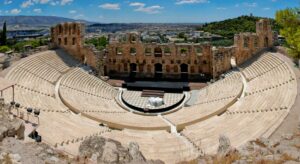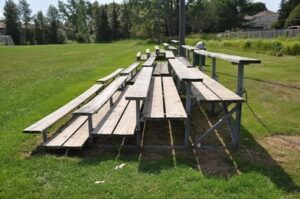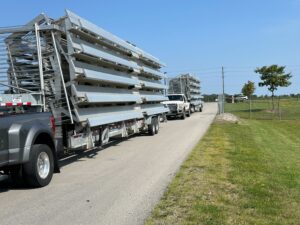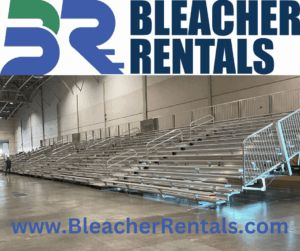Bleachers are a fixture at sporting events, parades, rodeos and more—but have you ever wondered where they originated? The concept of tiered seating has a surprisingly rich history, stretching back over 2,000 years. From ancient stone amphitheatres to high-tech mobile bleacher trailers, the evolution of bleacher design tells a fascinating story of engineering, culture, and innovation.
The Origins of Tiered Seating: Ancient Greece and Rome
The idea of tiered seating dates back to ancient civilizations. Greek amphitheatres and Roman coliseums, built between 300 BCE and 400 CE, used tiered stone seating to give large audiences a clear view of performances and gladiator battles. These open-air structures were often built into hillsides and could accommodate tens of thousands of people. This foundational principle—elevated rows for better sightlines—is still central to modern bleacher design.

Early Bleachers: Wood and the Birth of a Name
The word “bleachers” first gained popularity in the late 1800s in North America. At the time, wooden bench-style seating was installed at baseball fields, often exposed to the sun. Spectators seated there became known as the “bleacher bums,” and the term “bleachers” referred to the sun-bleached wooden benches themselves. These early bleachers were usually made of pine or fir and built on simple timber frames.
While effective for small gatherings, wooden bleachers posed challenges: they were prone to splinters, fire hazards, and deterioration from the elements. As sporting events grew in popularity and scale, a more durable solution was needed.

From Wood to Steel: A Structural Shift
By the mid-20th century, steel began replacing wood as the primary structural material. Steel provided greater strength and allowed bleacher systems to grow in size and complexity. Safety became a growing concern as bleachers were required to meet higher occupancy codes. Engineers introduced bracing, guardrails, and anchoring systems to prevent tipping or collapse.
This era also marked the beginning of standardized bleacher regulations, especially in public venues like schools and stadiums, setting the stage for further innovation.
Enter Aluminum: Lightweight, Durable, and Rust-Free
The 1960s and 70s saw the introduction of aluminum into bleacher construction. This material quickly became the industry standard because it was:
- Lightweight, making installation and transport easier
- Rust-resistant, unlike steel
- Low maintenance, ideal for long-term use
By the 1980s, most new bleachers in North America were being built with aluminum planks and steel or aluminum frames. The shift drastically improved safety, reduced maintenance costs, and extended the usable life of the structures.
Mobile Bleacher Trailers: Seating on the Move
As events became larger and more dynamic, a need arose for portable seating solutions. In the 1990s and early 2000s, hydraulic mobile bleacher trailers were developed to provide seating that could travel from venue to venue and be set up quickly.
These units revolutionized the event industry:
- Setup time was reduced to under 30 minutes
- No heavy machinery or large crews were required
- One trailer could serve multiple events across a region
Today, mobile bleachers are a go-to solution for municipalities, school districts, sports leagues, and event organizers who need reliable seating with minimal logistics.

The Legacy Lives On
From ancient amphitheatres carved into stone to the fold-out convenience of mobile trailers, bleachers have come a long way. Yet their purpose remains the same: to bring people together to witness something memorable.
At Bleacher Rentals, we’re proud to carry this legacy forward—with the safest, most efficient, and innovative seating solutions available today. Because no matter the event, everyone deserves a good seat!

